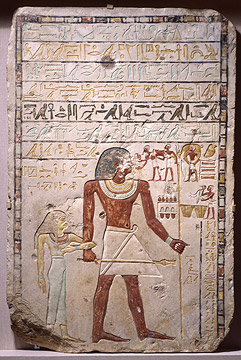Image Resource Bank
Image Gallery |  3 of 15
3 of 15 
Uha and His Wife, Henutsen
This funerary stela of Uha begins and ends with traditional formulae intended to encourage visitors to the tomb to make invocations on behalf of the tomb owner. However, the central portion of the inscription is a unique record of his circumcision (perhaps a rite marking puberty) along with other boys followed by a claim that he always lived off his own possessions, not what he inherited from his father (and not, presumably, off the property of others or the state).
Uha is shown with his wife Henutsen, who is much smaller in scale (although still much larger than the servants shown offering to the couple). As is traditional, the wife puts her arm around her husband, although here she holds his arm rather than his shoulder because of the disparity in size. Both Uha and the male servants are depicted with dark reddish brown skin tones while Henutsen has light yellow coloring. This reflects the standard differentiation between male and female which has been suggested to reflect the fact that women normally stayed indoors to run the house while men worked outside the home and were subject to much more tanning from the sun. The unusual use of alternating lines of color in the hieroglyphs highlights the dual role of the writing as text and as a decorative element.
Name: Stela of Uha and His Wife, Hentusen
Material: Limestone, pigment
Size:
Width: 71.1 cm (27.75 in)
Height: 111.7 cm (43.5 in)
Date: c. 2250-2134 BCE,
First Intermediate Period, Dynasties 7-10
Place of Origin: Naga ed-Deir, Egypt (?)
Location: Oriental Institute Museum, Chicago, Illinois
Source, Registration#, and Publication: Oriental Institute Museum, 16956. Teeter, Emily, Treasures from the Collection of the Oriental Institute, Chicago: The Oriental Institute of the University of Chicago, 2003. p. 33-34

 Janet H. Johnson
Janet H. Johnson
Morton D. Hull Distinguished Service Professor of Egyptology




